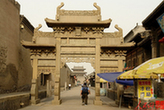During Qing Dynasty (1644-1911) and the period of Republic of China (1912-1949), the handles of Tibetan seals changed in shape greatly. Most of the seals (including royal seals used for conferring official titles, seals of the temple, Lama’s seals and noblemen’s seals) were Ru Yi Bao Guan (seal with a coronet-shaped handle) and Bao Zhu Niu (seal with a pearl-shaped handle), while the rest were Shang Xia Fang Yin (cube-shaped seal), Shang Xia Yuan Yin (cylinder-shaped seal), Wa Niu Yin (seal with a tile-shaped handle), Zhi Niu Tie Yin (iron seal with a elliptic-cylinder-shaped handle), Mu Niu Tie Yin (iron seal with an wooden handle), Shou Xing Niu Yin (seal with a handle shaped like the God of Longevity), Lian Zhi Niu Yin (seal of a locus-shaped handle) and Shi Niu Yin (seal with a lion-shaped handle).
Gold seal with iron inlays, a buckskin ribbon and a handle engraved with a pearl and double capsized lotus, during the Sakya Authority in Tibet, Yuan Dynasty |
Artistic Ideas
Tibetan people have manifested a spirit of rationality through the art of seal-engraving, including design, craftsmanship, realism, impressionism, visual thinking and implicit meaning. Philosophical thoughts of Buddhism - “Yuan Tong (completion and thorough understanding)” and “Yuan Jue (thorough understanding of oneself and others)” - have found full expression on the patterns, scripts and totems carved on the seals. They blended squares with circular forms and integrated lines with curves. Closed designs were more than continuous ones, while dots and arcs were more than right angles and squares. Durable, simple, flexible and sturdy, the seals represented mystery, charm, harmony and beauty.
Rhodium seal with a yellow silk ribbon and a handle engraved with Hu Xing Bao Wen (pattern of arc-shaped treasures), Ru Yi Wen (scepter border pattern), Jin Gang Jie (an amulet that looks like a Chinese knot) and Jin Gang Chu (vajra), during the Phakmo Trupa Authority in Tibet, Ming Dynasty (1368-1644) |
The art of seal-engraving came from life and displayed life. Although small in size, even 1 to 2 centimeters in length, width and height, ancient Tibetan seals had profound connotations. With superb artistic skills, ancient Tibetan engravers carved out lifelike auspicious creatures. Surprisingly, not only were they proficient at engraving familiar creatures, but they could sculpt precisely abstract totems and special birds and beasts which were rare at that time. Furthermore, they showed their sensitivity to anything new and their boldness of vision to assimilate foreign things though seal engraving.





Why not rent a boyfriend, or girlfriend to please parents during the Spring Festival?